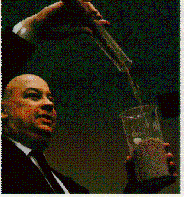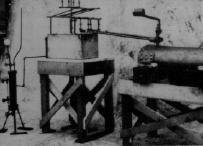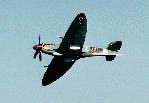







The early history of FBRs is interwined with World War II and involved tremendous amounts of engineering skill and capital expense by over 400 oil and chemical processing companies.
In the early 1900's, the Standard Oil Company, then the largest oil company in the world, was using temperature distillation and thermal cracking to refine crude oil into different products; such as, kerosene, fuel oils and lubricants. At the same time, Standard was researching alternative methods of "cracking" the lower value long-chain crude oil molecules into the high value smaller molecules of the fuel and lubricant products.
 It wasn't until the mid-1920's that there was a significant breakthrough allowing the development of a better "cracking" unit. In Europe at this point, advances in catalyst technologies were being used to convert coal into oil.
It wasn't until the mid-1920's that there was a significant breakthrough allowing the development of a better "cracking" unit. In Europe at this point, advances in catalyst technologies were being used to convert coal into oil.
Copyright, Unocal 1990
 An array of different catalyst types
An array of different catalyst types
Copyright, Unocal 1990
In 1936, a process was developed called the Houdry Process. It used a fixed-bed catalyst to "crack" petroleum molecules. In this process the catalyst was prone to coking. This required that the coke deposits be burned off periodically. For the first Houdry cracking unit, the time required to burn off (regenerate) the coke was equal to the time the unit had been running. That is, for every ten minutes of cracking time, there was a ten-minute regeneration time. However, this was not the only problem with the Houdry Process. The Houdry Process had a license fee of $53M, roughly $600M in today's dollars. Needless to say, Exxon Research (a descendent of Standard Oil) thought they could do better than that.
 Late 1930's prototype catalytic cracking unit
Late 1930's prototype catalytic cracking unit
Copyright, Exxon 1993
In 1938, Exxon Research joined a consortium of large oil and processing companies to further develop the catalytic "cracking" process. They eventually came up with the concept of a moving bed of catalyst.
The moving bed was termed "fluidized", as it moved and had properties analogous to a fluid. While regeneration still required shutting down the process, there were a number of benefits associated with the new process. When used for gasoline production this type of process delivered higher octane gasoline and increased production as compared to the previously mentioned Houdry units.
The first production facility using the fluidized bed concept for the catalytic cracking of petroleum feedstocks came online at 2:25am on May 25, 1942.

The startup of the Exxon Catalytic Cracking Unit in Baton Rouge, Louisiana, 1942
Copyright, Exxon 1993

In the years prior to the startup of the first fluidized bed reactor, the world saw the rise of two very strong militaristic countries, Germany and Japan. These two countries, together and separately, pursued a path that forced most nations of the world to chose sides. Germany and Japan had been stretching their military muscles during the 1930's, and by 1939 Europe and Asia were in a fight for their lives.
When Britain entered the war against Germany in 1939, the main suppliers of 100-octane aviation gasoline were companies whom had joined together to research catalytic cracking of crude oil. In the summer of 1940, Britain was under air attack from bases in the now German-held France and Belgium. Using 100-octane gasoline, British fighter aircraft performed better and were able to match and finally outperform the attacking German airforce. The British minister of fuel and power at that time, Geoffrey Lloyd, indicated later that, "... without the 100-octane we should not have won the Battle of Britain" [1]. The Battle of Britain was a decisive air battle fought in the skies above England in mid-1940.
After the catalytic cracking units came online in 1942, production of 100-octane and many other fuels increased dramatically. By 1945, there were 34 cracking units online were producing 240,000 barrels per day - roughly 45% of US production. However, the production of fuels and gasoline components is not the end of the story.
In the Pacific, the Japanese had gained control over land stretching from Manchuria to the Philippines.
The Philippines and Indonesia were the principal source of raw materials for the US rubber industry. With those natural rubber supplies cutoff, the US had to increase its production of synthetic rubber. The new source for for compounds used to produce synthetic rubber came from the fluidized bed reactors. New FBRs were coming online due to the acceleration of FBR processing necessary for wartime production.
Anonymous, Catalytic Cracking, Exxon Report, pp. 17.
Back to Battle of Britain.
Go to Top of Page
Jim Sterling at Alaska Image Scanning.
Photos of vintage WWII aircraft courtesy of: